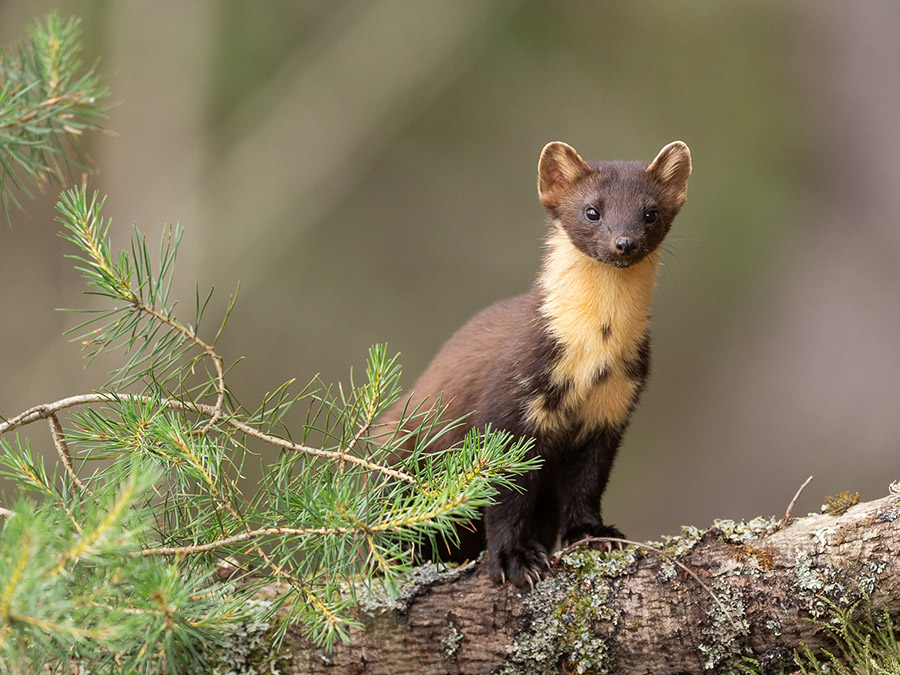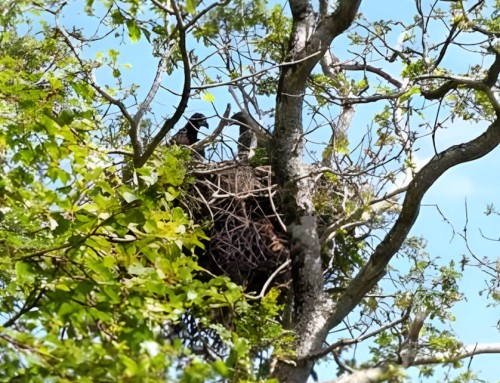In my earlier blogs, I mentioned that I would try to explain how my wife Lynne and I go about photographing particular wildlife species when we are on holiday. This article looks at our techniques for capturing the Pine Marten, one of the key species that keeps drawing us back to Ardtornish year after year.
Pine marten are incredibly photogenic. Luckily, they can often be photographed during the daytime in Summer, particularly when a mother is feeding young kits. Later in summer, those kits start to venture out of the nest with her, or by themselves as they get older and bolder. This time of year can offer some really good opportunities to capture these family groups interacting and playing. But by autumn when we usually visit Ardtornish, they will have returned to a nocturnal lifestyle, so we must adapt to photographing them in the dark. We go about this in a few different ways.
Fortunately, Pine Marten can be quite inquisitive and confiding animals, and we spend the first couple of days of any holiday trying to win their trust. We put out suitable food like peanuts, raisins, honey, and the occasional road casualty (such as small birds), but not the jam sandwiches that are so often suggested. We have even been known to take a bag of the frozen mice that pet shops sell as lizard or snake food with us.
We initially monitor the level of activity with strategically placed camera traps / trail cameras. When we know the Pine Marten are visiting regularly, we try to gradually introduce some light – initially by leaving the cottage outside light on and leaving the curtains open.
We do have some more sophisticated lighting that we can control via a dimmer switch. Experience shows that provided we don’t rush the process, or turn these lights up too far, then the Pine Martens quickly accept the situation and will happily visit for long periods. There will always be the odd individual that is more cautious and stays in the shadows as much as possible, but then there’s occasionally the precocious one that tries to climb in through the kitchen window to tell us when the food has run out!
We also have some more specialised camera trapping equipment, that allows the use of a ‘real’ DSLR or mirrorless camera housed in a waterproof casing. This means it can be safely deployed in even the worst Highland weather. A number of electronic flash guns, again protected with waterproof covers are linked wirelessly to the camera. A passive infra-red switch, (similar to the sort fitted to external security lights and in trail cameras) is also linked wirelessly to the camera. This then triggers the camera to take a picture, when motion is detected in the infra-red beam.
This remote camera is set up and pre-focussed on a particular area where we hide some food. This area will be illuminated by the electronic flash units, usually positioned off to either side of the camera. By using higher ISO settings on the camera, the flash power can be reduced so as not to spook the pine martens and deter them from visiting. We always introduce the flash guns gradually and monitor the pine marten’s response to the sudden flash; by videoing what happens using a trail camera. Experience shows that the animals usually take no notice, particularly if they are tucking into their free meal.
There are a number of factors we try to take into account when picking the area in which we want to photograph the Pine Martens. Ideally, we want to be able to photograph them from an open window in the cottage. This way we are concealed, but can sit in relative comfort inside, albeit in the dark with the window open!
The kitchen window in Keeper’s Cottage is great for this and the windows in the porch can also be useful. We try to set things up so the Pine Marten are close enough to the cottage that we can get frame filling photographs without the need to use big telephoto lenses, but not so close that the animals are scared to approach. This can sometimes make for interesting evenings! Trying to cook and then eat dinner in silence, in the dark, with only the light from a red filtered head torch is a challenge everyone should try at least once!
We always try to have an interesting background in our pictures. On the lawn outside is OK but does mean that you are looking down on the animals. Wildlife photos always tend to look more natural and have more impact when taken at the animal’s eye level.
For that reason, we always take a folding table on holiday with us, just in case our cottage doesn’t have an outdoor picnic table or anything else that we might be able to utilise. (Keepers Cottage is also great in this regard). We call this our “cheating table”, and we cover it with a groundsheet and then add natural materials such as moss, rocks and fallen branches from the woods, to create a realistic looking miniature landscape. We try to ring the changes on our diorama every couple of days, to give us a good selection of photos.
The hard work of repairing the damage caused by numerous visitors the night before (hopefully!) and creating something that looks natural and realistic is done during the day, to minimise disturbance. Unless our trail cameras show we have daytime visitors, we usually wait until it’s getting dark before we put out the food, so the garden birds don’t eat it all. We hide the food in natural pockets and hollows in our diorama, so it is not apparent in our photographs.
Then it’s time to just sit back and wait!











